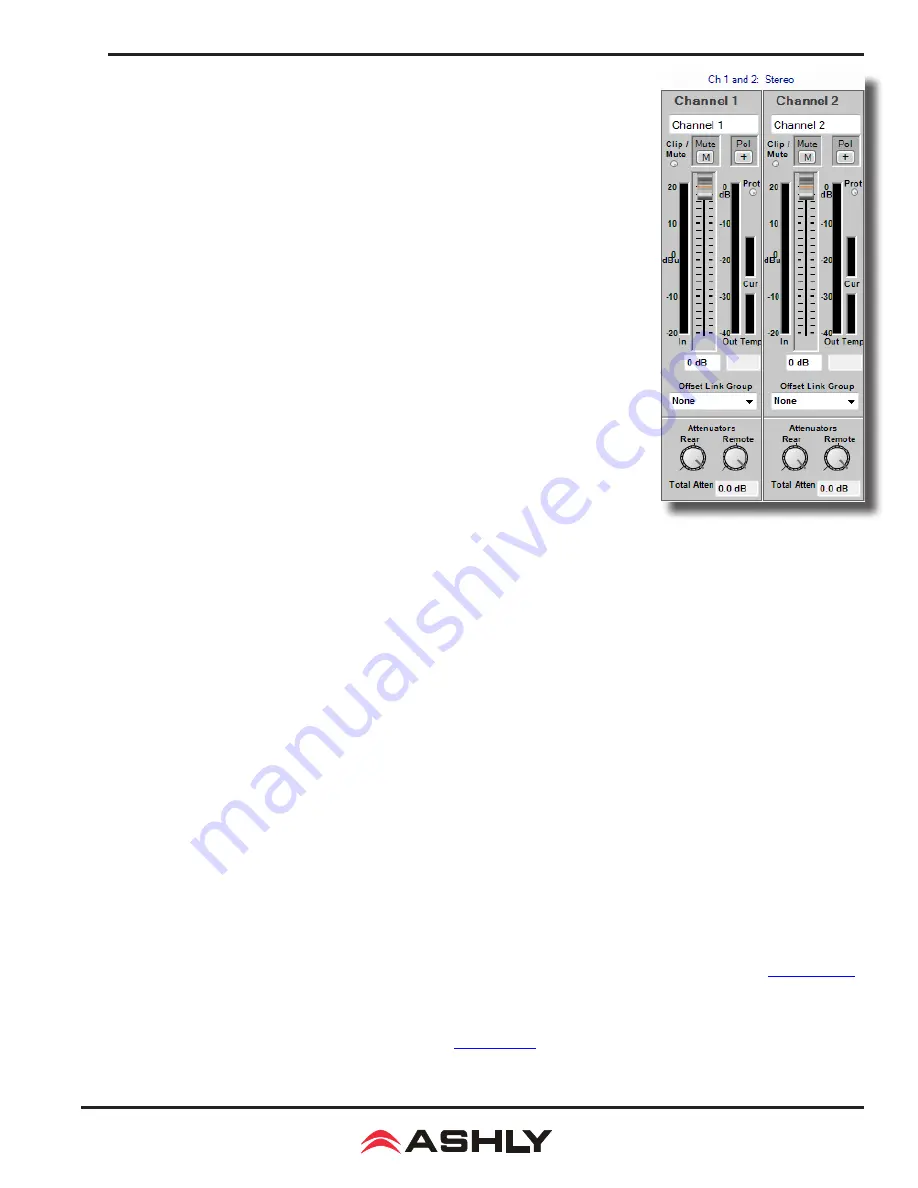
21
Operating Manual - nX, nXe, and nXp 150W/75W Power Amplifiers
9.4a (continued) Software Control Surface - Channel
Stereo/Bridged Status
- This shows if a channel pair is in stereo or bridge mode as set by
back panel switch. In bridge mode, input signal is automatically taken from the odd chan
-
nel input and inverted, then sent to the even channel. The even channel controls become
disabled. Note that in bridge mode, the even channel software attenuators will still reflect
the physical position of the amplifier's front panel attenuators, even though they are removed
from control of bridged signal.
Channel Name
- This user defined text box names the amplifier output channel. Up to
20 characters can be used.
Clip/Mute LED
- This LED shows when the amplifier output is either muted or clipping.
Clipping is indicated when the output level is 1dB below the output power supply rail
voltage, and accurately tracks AC line voltage sags. This LED shows the same status as the
front panel clip/mute LED.
Mute Button
- This button mutes the output channel. Output mute can also be controlled
by the event scheduler, WR-5, or neWR-5 remotes.
Polarity Button (Pol)
- This button inverts the polarity of the output channel signal.
Input Meter
- This meter indicates the pre-fader amplifier input level in dBu.
Main Output Channel Fader
- This controls the output attenuation.
Output attenuation
below -40dB mutes the output.
Output Meter
- This indicates the amplifier output level in dB below full rated output.
Protect Indicator (Prot)
-
These indicate an over-temperature, power limiting, or power supply voltage fault on individual channels.
Current Meter (Cur)
- The Current LED shows that the amplifier is delivering current to a load, and is useful to determine
if a speaker load is open or shorted.
Temperature Meter (Temp)
- The temperature meter and text box shows the current operating temperature of the output
devices for each channel. Excess of 100°C will trigger overtemperature protection.
Offset Link Group and Offset Faders
- A group of output channels can be linked together to attenuate the group as a
whole without changing the relative levels of each channel. If a channel is assigned to one of the 16 offset link groups, a colored
triangle marker appears on the left side of the main fader graticule for secondary level control of all channels in that group. Left
click and drag this marker up or down to adjust the link group level. The actual main output channel faders can not be linked to
a group. Note that more than 40dB of cumulative channel attenuation causes the channel to mute.
In addition to the control surface offset link group attenuator control (not the main fader), most DSP functions have a link group
check box in their work window to assign a specific DSP parameter to one of 16 link groups if desired. Link groups can be
renamed by clicking on any group name and entering the new name.
Attenuators
- These two dials indicate the physical position of hardware level controls on either the amp front panel or the
remote DC level control. Note that these will display the position of attenuators even when they are disabled.
Total Attenuation
- This indicates the total amount of attenuation being applied to the channel. It is the sum of the following
attenuation points: control surface fader, offset link group attenuation, front panel level control, and remote attenuator.
Note: The maximum dynamic range of the amplifier is achieved when the amplifier’s attenuation is set to the optimal value.
The amplifier’s front panel attenuators follow the DSP section but precede the power amplifier section (see
).
Thus, the optimal setting for maximum dynamic range is determined by subtracting the amplifier's input sensitivity from the
maximum input signal of +20dBu. For example, when the back panel gain DIP switch is set for gain of 1.4V, the input sensitivity
is +5.1dBu (1.4Vrms = +5.1dBu). Su5.1dBu from +20dBu, and that results in 14.9dB attenuation required for optimal
dynamic range. For other input sensitivity values, see the
9.4a - Control Surface
Channel Functions
















































